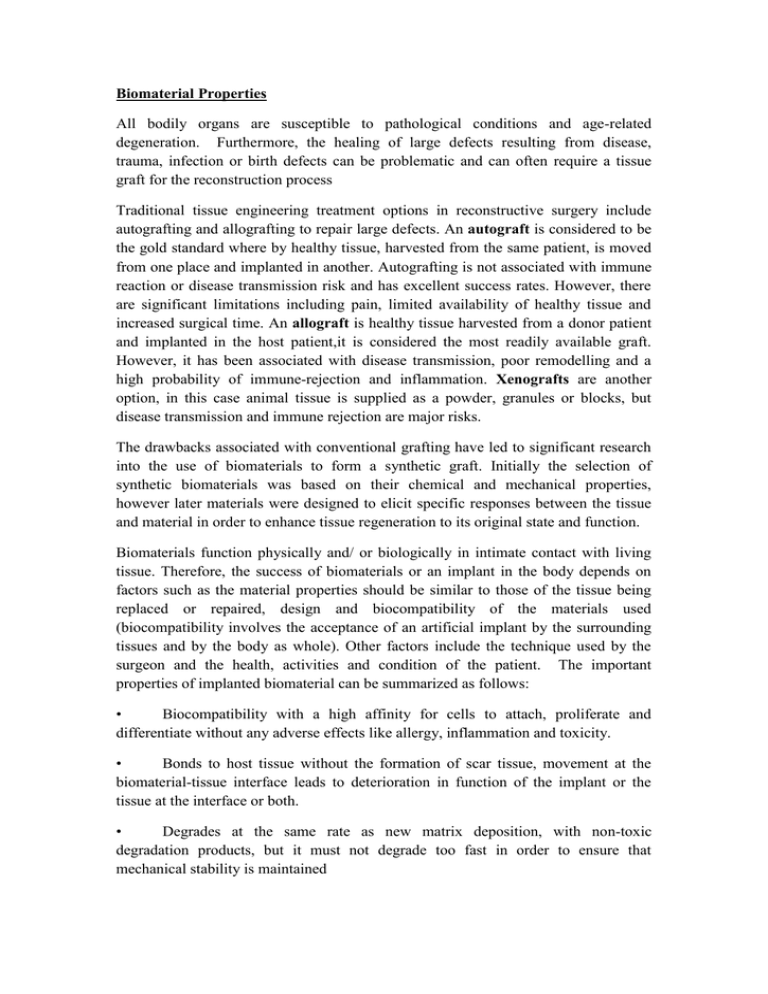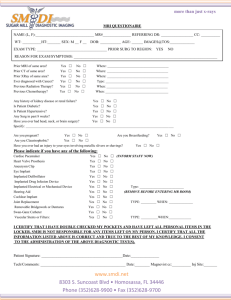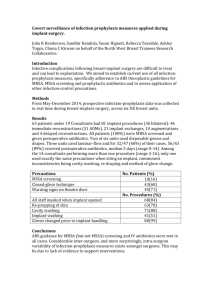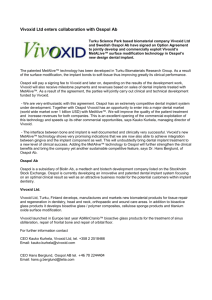Biomaterial Properties
advertisement

Biomaterial Properties All bodily organs are susceptible to pathological conditions and age-related degeneration. Furthermore, the healing of large defects resulting from disease, trauma, infection or birth defects can be problematic and can often require a tissue graft for the reconstruction process Traditional tissue engineering treatment options in reconstructive surgery include autografting and allografting to repair large defects. An autograft is considered to be the gold standard where by healthy tissue, harvested from the same patient, is moved from one place and implanted in another. Autografting is not associated with immune reaction or disease transmission risk and has excellent success rates. However, there are significant limitations including pain, limited availability of healthy tissue and increased surgical time. An allograft is healthy tissue harvested from a donor patient and implanted in the host patient,it is considered the most readily available graft. However, it has been associated with disease transmission, poor remodelling and a high probability of immune-rejection and inflammation. Xenografts are another option, in this case animal tissue is supplied as a powder, granules or blocks, but disease transmission and immune rejection are major risks. The drawbacks associated with conventional grafting have led to significant research into the use of biomaterials to form a synthetic graft. Initially the selection of synthetic biomaterials was based on their chemical and mechanical properties, however later materials were designed to elicit specific responses between the tissue and material in order to enhance tissue regeneration to its original state and function. Biomaterials function physically and/ or biologically in intimate contact with living tissue. Therefore, the success of biomaterials or an implant in the body depends on factors such as the material properties should be similar to those of the tissue being replaced or repaired, design and biocompatibility of the materials used (biocompatibility involves the acceptance of an artificial implant by the surrounding tissues and by the body as whole). Other factors include the technique used by the surgeon and the health, activities and condition of the patient. The important properties of implanted biomaterial can be summarized as follows: • Biocompatibility with a high affinity for cells to attach, proliferate and differentiate without any adverse effects like allergy, inflammation and toxicity. • Bonds to host tissue without the formation of scar tissue, movement at the biomaterial-tissue interface leads to deterioration in function of the implant or the tissue at the interface or both. • Degrades at the same rate as new matrix deposition, with non-toxic degradation products, but it must not degrade too fast in order to ensure that mechanical stability is maintained • It should present mechanical properties that sufficiently match that for the indicated application. • Easy of forming into sometimes complex shapes, and with strict dimensional tolerances. • They should be sterilized without damage (porous or rough surface favours mechanical stabilization of the implant). Biological properties Different levels of interaction can be discerned: with biological fluids, with tissues and with cells. Furthermore, the biological behavior gets modified with time, often related to modification in the surface of the implanted ceramics or their degradation. 1. Ceramic- tissue interaction Ceramic-tissue interaction determines the integration of ceramic in its environment (biointegration). Several parameters play an important role in this interaction, material surface properties, such as The mechanical anchorage, which ensures the initial stability of the implant and the chemical anchorage, which actually determines the integration of the implant with its host organism. Implant stabilization using a nearly inert material in a living tissue associated with a series reactions leading to the formation of a fibrous encapsulating tissue around the implant, this tissue ensures the joining between the healthy tissue and the implant, this form of biointegration is considered to be relatively poor quality because it allows a relative mobility of the implant and the existence of micromovements, which eventually associated with the phenomena of abrasion and with an inflammatory process. Therefore Implants made of these materials must be mechanically fixed in place with screws or a similar mechanism that does not rely on a strong tissue-implant interaction. In addition, the surface morphology can effect on the mechanical anchoring of the implant, a porous or rough surface favors mechanical stabilization of the implant which is called adequate “morphological fixation”. Ceramic-tissue bonding the integration of the implant can also be ensured by the interactions of a physicochemical nature with the tissue. These phenomena have been more particularly studied for ceramics used in orthopedics. When a bioactive material is implanted, the biochemical reactions that occur at the interface between the tissue and the implant can initiate what is commonly called “bioactive fixation”. So a bioactive material has a behavior that is between a resorbable and an inert implant and is capable to create an environment that can stimulate the creation of a perfect bond between the living tissue and the inert material of the prosthesis when used as coating layer. In the case of apatitic structure as well as other type of non-apatitic materials, even other amorphous materials such as bioglasses, the formation of a carbonated apatite(bonding layer), analogous to bone mineral highly dependent on the factors associated with the implanted biomaterials (nucleation sites) and its environment (protein adsorption ). Mechanical stresses:The implant integration of the bone tissue depends on biomechanical factors, the absence of mechanical stress lead to slow down of cell activity and bone remodeling. It has been demonstrated that the lack of stress can cause the bone density to decrease as the bone tissue tends to resorb .the difference in mechanical properties of implant and host tissue cause a mechanical stresses at the bone interface.






